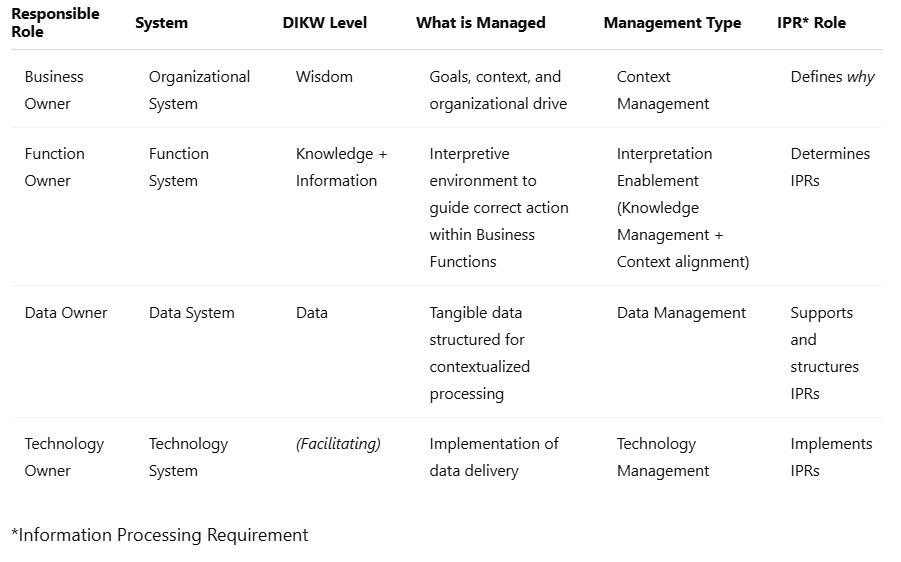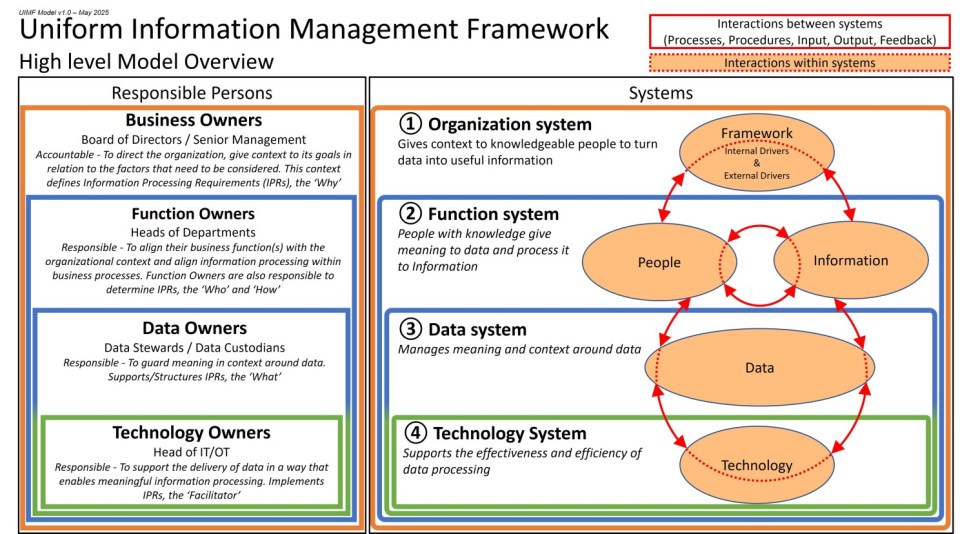
Information does not exist in systems. It exists in people. Yet we treat it like a technical object — something that can be owned, stored, or automated. UIMF challenges that view. It provides a structural lens to see what information really is: the result of interpretation.
This article builds on the foundation introduced in my earlier article, which introduced UIMF. Here, we zoom in on the UIMF model itself — the structure that helps organizations manage meaning, data, and delivery in a way that connects strategy to execution.
UIMF does not invent new responsibilities. It reveals roles that already exist, often unconsciously, and aligns them across silos. By defining Information Processing Requirements (IPRs), it shows how organizations can manage information meaningfully by managing the conditions for interpretation.
Information is not an object. It is the result of a living being interpreting data in context.
UIMF: From Organizational Context to Actionable Information
UIMF introduces four interlinked roles, each connected to a distinct system and a corresponding level of the DIKW hierarchy. The next table reflects this:

Each role can be fulfilled by one or multiple individuals, depending on the scope and scale of the organization. These roles typically already exist within the organization — UIMF simply makes them visible, assigns accountability, and aligns them with the correct system and responsibility. The power of the framework lies in how it connects strategy to execution.
The next visual representation maps each role to its corresponding system and responsibility. It also shows how context, meaning, and data flow between systems through structured roles and governed interactions. This structure forms the foundation of the Uniform Information Management Framework:

Explanation per role and system
Business Owner – Framing the Organizational System
Business Owners are accountable for the Organizational System. They set goals and objectives based on internal ambitions and external drivers (regulations, market demands, customer expectations). With consultant support, they frame the organizational context: what should we achieve and under what conditions? This is the Wisdom layer in DIKW. It requires understanding not only what must be done, but why — translating vision into direction. This forms the organizational backbone that informs what is needed downstream in terms of functions, information, and people.
Function Owner – Realizing the Information System
Function Owner – Realizing Business Functions (Function System)
In larger organizations, Business Owners appoint Heads of Departments who become Function Owners by mandate. They are responsible for business functions aligned with the organizational context defined by the Business Owner. To ensure tasks are effectively fulfilled, they hire or contract people with the right knowledge. Additionally, they define the Information Processing Requirements (IPRs), which describe how data should be processed and interpreted within that function to produce the appropriate actions. These IPRs translate strategic context into operational instruction — forming the interpretive guideposts that Data and Technology Owners must support.
These tasks involve interpreting data as information, and thus the Function Owner becomes responsible for managing the interpretive environment — not information itself — which includes ensuring:
- That the right data is presented to the right people;
- That people have the knowledge to interpret that data meaningfully;
- That the context for correct interpretation is clear and consistent.
Function Owners don’t manage information as an object. Instead, they manage the conditions for interpretation: ensuring that people have the right knowledge to process data in such a way that the correct actions follow — actions that realize the business function they are responsible for.
This aligns with a key insight that reframes the meaning of Information Management within UIMF:
Information does not exist independently of human perception. It arises when a living being interprets data within a specific context — and that interpretation forms meaning.
This formula captures this:
Information = Living Being + Meaning(Interpretation of Data × Context)
In this way, the Function Owner manages not information as a static object, but the interpretive conditions necessary for information to arise. When actions taken by staff show misunderstanding or error, the Function Owner examines whether the issue lies in unclear data, insufficient knowledge, or an inadequately communicated context — and adjusts accordingly.
The Function Owner ensures that these ingredients are aligned, available, and actively working in practice — not theoretically. That is how interpretation becomes reliable, and information supports purposeful action.
Data Owner – Structuring the Data System
While meaning and information are abstract, data and context are tangible. Where Business Owners define context, and Function Owners ensure meaningful interpretation, Data Owners are responsible for making the data traceable and aligned with its intended meaning.
They structure and classify data in a way that enables interpretation by the right people in the right context. Although Function Owners are responsible for how data is interpreted and applied within their business function, Data Owners are accountable for ensuring that the data is correct, structured, and available for meaningful interpretation across the organization. Their responsibility is to ensure that the data is available, accurate, and embedded with the metadata necessary to reflect organizational context — so that the Function Owner can ensure it’s offered to the correct people in a usable form.
Data Owners do not determine meaning — they safeguard the integrity and usability of data so others can assign meaning correctly. In this sense, Data Management is meaning-sensitive. It provides the structured raw material from which interpretation emerges.
This directly supports the logic behind the information formula: Information = Living Being + Meaning(Interpretation of Data × Context).
Technology Owner – Enabling the Technology System
Technology Owner – Enabling the Technology System
The Technology Owner is responsible for ensuring that the systems used to deliver data—whether digital platforms or other supporting environments— to people, are correctly aligned with the Information Processing Requirements (IPRs) defined by the organization. While many organizations associate technology strictly with IT, the UIMF approach explicitly broadens this view: technology includes all formalized methods and tools that support the delivery of data to the right people, at the right time, and in the right form — not just digital systems, but also methods rooted in human interaction and non-IT techniques, such as reading a book or interpreting environmental signals through vision or hearing. This centers the role of human interpretation, rather than the tools or techniques applied.
This reframing is essential, as many organizations fall into the trap of starting and ending with IT as a goal in itself, rather than a means to an end. The Technology Owner must therefore understand both the required context and the meaning of the data being delivered, and ensure that the technological environment — in all its forms — facilitates, rather than obstructs, correct interpretation. This can include traditional IT infrastructure, but also platforms for collaboration, reporting environments, knowledge management tools, and interface design that enables shared understanding.
They implement Information Processing Requirements (IPRs) into these systems and environments, as managed by the Data Owners, ensuring that the delivery mechanisms not only preserve data integrity but remain aligned with the meaning established by Function Owners and the organizational context set by Business Owners. In this way, the Technology Owner turns the technology environment into a supportive channel for contextualized data access, creating the technology system in the context of the organization.
Technology Management in UIMF is therefore about enabling reliable, contextualized, and meaningful access to data. Without this alignment, the organization risks providing people with information that is fragmented, misleading, or detached from purpose.
A Chain of Alignment: Avoiding Information Loss
A Chain of Alignment: Avoiding Information Loss
Each system is dependent on the proper function of the others:
- If Context is unclear, then the meaning of information becomes subjective.
- Without clear Meaning and Context, interpreting Data becomes a matter of personal judgment (People) — reliant on individual expertise rather than on structured, interconnected systems. As a result, optimization becomes a matter of chance.
- If we don’t structure Data in alignment with Meaning and Context, People can’t interpret it reliably — and the organization can’t refine it into 24 karat gold: optimized, aligned, and ready to create real value.
- If Technology fails to present Data in line with Context and its intended Meaning, People can’t effectively process, access, or interpret it.
Thus, all four management types — Context, Meaning, Data, and Technology — must be aligned. Misalignment means information becomes confined within specific functions, depending completely on the knowledge and expertise of individuals, unable to support others who need it to optimize their work and get goals realized more easily and faster.
This is why UIMF is not just about ownership. It is about restoring the meaning and manageability of information through structurally aligned roles.
Closing the Loop
UIMF helps organizations identify where their responsibilities already lie, even if not yet named or structured. It captures the logic of information flow from purpose to action, context to content, and decision to realization. And it does so in a way that is tangible, assignable, and measurable.
What UIMF Offers Organizations: Revealing, Resolving, and Realizing Value
The Uniform Information Management Framework (UIMF) is more than a structural framework—it’s a lens through which organizations can recognize and resolve deeply embedded challenges in how they manage information.
Where other frameworks prescribe actions within their own domains (e.g., data quality, IT services, or risk governance), UIMF defines the shared foundation all these frameworks depend on: context, meaning, and ownership. This shared foundation enables organizations to integrate these frameworks successfully — preventing them from operating in silos.
UIMF clarifies the invisible
Many organizations suffer from unclear responsibilities and unspoken dependencies. UIMF reveals these blind spots by making them explicit:
- Who defines context and goals (Business Owners)
- Who guards the translation of context and the correct implementation and application of meaning to business functions (Function Owners)
- Who structures and supports the data so meaning can travel across departments and systems (Data Owners)
- Who ensures that technology delivers data in a way that preserves its intended meaning and enables correct interpretation (Technology Owners)
By surfacing these roles and their interdependencies, UIMF helps organizations turn ambiguity into alignment.
UIMF reframes challenges as solvable
The issues organizations face—unclear metadata, lost meaning, overreliance on IT, and business departments failing to take their role to ensure correct data processing, leaving it to the IT department—are not new. UIMF does not introduce complexity; it names and orders it. It shows:
- That Business Owners need to clearly determine and manage organizational context.
- That Function Owners are responsible for Business Functions (usually Heads of Departments) who need to structure and steer the correct interpretation of data within their business function — making information management tangible and aligned with organizational context
- That Data Owners structure and enrich datasets with context and semantic information — enabling meaning to flow across teams, systems, and interpretations
- That Technology should serve, not steer, information flows
UIMF enables integration and accountability
Organizations looking to implement ISO 27001, ITIL, DAMA-DMBOK, NIST, or COBIT often struggle with overlap or fragmentation. UIMF provides the semantic and structural backbone that makes integration possible. It enables all standards to work in concert, guided by shared roles and a clear flow from purpose to data.
UIMF delivers real organizational value
By aligning people, systems, and governance structures around meaningful information, UIMF helps organizations:
- Make better, faster decisions
- Avoid rework and miscommunication
- Reduce dependence on individuals by building knowledge into processes
- Adapt more quickly to change
- Enable external parties to align with internal goals
In essence, UIMF does not merely propose new ways of working—it reveals what’s already happening beneath the surface and gives organizations the structure to manage it deliberately. It turns the unconscious competence of your people into conscious, scalable capability.
Now that we’ve explored the framework, it’s time to explore how to bring it to life. In the next article, we’ll introduce the UIMF PDCA Cycle — a dynamic, cyclical process that enables organizations to implement and orchestrate the framework in practice.
UIMF shows you where meaning lives in your organization — and how to manage it.

 English | EN
English | EN 